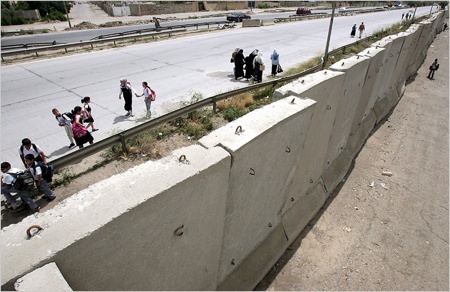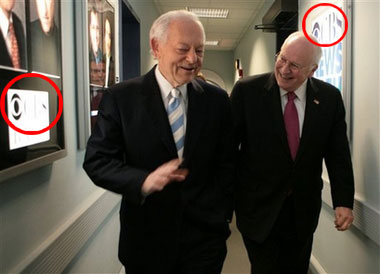Notes
The Happy Wall
In the nine days since I started squawking about the invisibility of Iraq’s new, American-sponsored security wall(s), various pictures have emerged. The bellwether that it is, the NYT has twice stepped up to the task. The first time was on the 23rd. The second time was yesterday, in a piece in the Week In Review.
What disturbs me about the images run by The Times, however, has to do with their apologist tendencies.
In the shot accompanying the article published on the 23rd, we have a pleasant scene of children, supposedly safe to resume playing soccer, now that the wonderful Iraq wall is behind them. Also, given the angle, you don’t get the sense the wall extends all that far. The apartment building looming behind the wall also lends a sense of domesticity, and the funny stack of rocks in the foreground, far right, gives you the balancing sense that, with chunks of concrete all around, what trouble could just a little more cause?
Which brings me to the photo that accompanied yesterday’s Week In Review piece. The photo of the wall (above), in juxtaposition with the article, is completely contradictory. Textually, the article explains why the wall — both politically and militarily — is likely doomed for failure. If even The Times now sees the wall as unworkable, however, why does the image conceptually endorse what the wall defies?
Besides the suggestion, as in the soccer shot, that families can now move freely and children (see backpacks) can safely go to school, more complicating is the device of “two sides.” Although the the wall is doomed, we are told, because it hopelessly sets up innumerable “us versus us” conditions, the photo thoroughly reinforces an “us versus them.” Specifically, we see the good road of progress versus the bad (or dirt) road of neglect. We see the “good side” of family, education, collectivism and movement — involving those good Muslims! — versus the single, lone, estranged probably male who-knows-who, isolated as “the other.”
When you put it that way — in good old GWOT terms, I mean — you’ve got that “evil-doer” language going again, with actual facts and meaning simply walled off.
Note: What the article also does, but only in the briefest way textually, is to juxtapose the Iraq Wall with other infamous walls, including the Great Wall of China (leading the story), the Berlin Wall and the Israeli Wall. Because the article presents these walls, visually, as a collection, I invite you to take on how that plays.
(image: Ali Haider/European Pressphoto Agency. April 29, 2007. nytimes.com)



Reactions
Comments Powered by Disqus